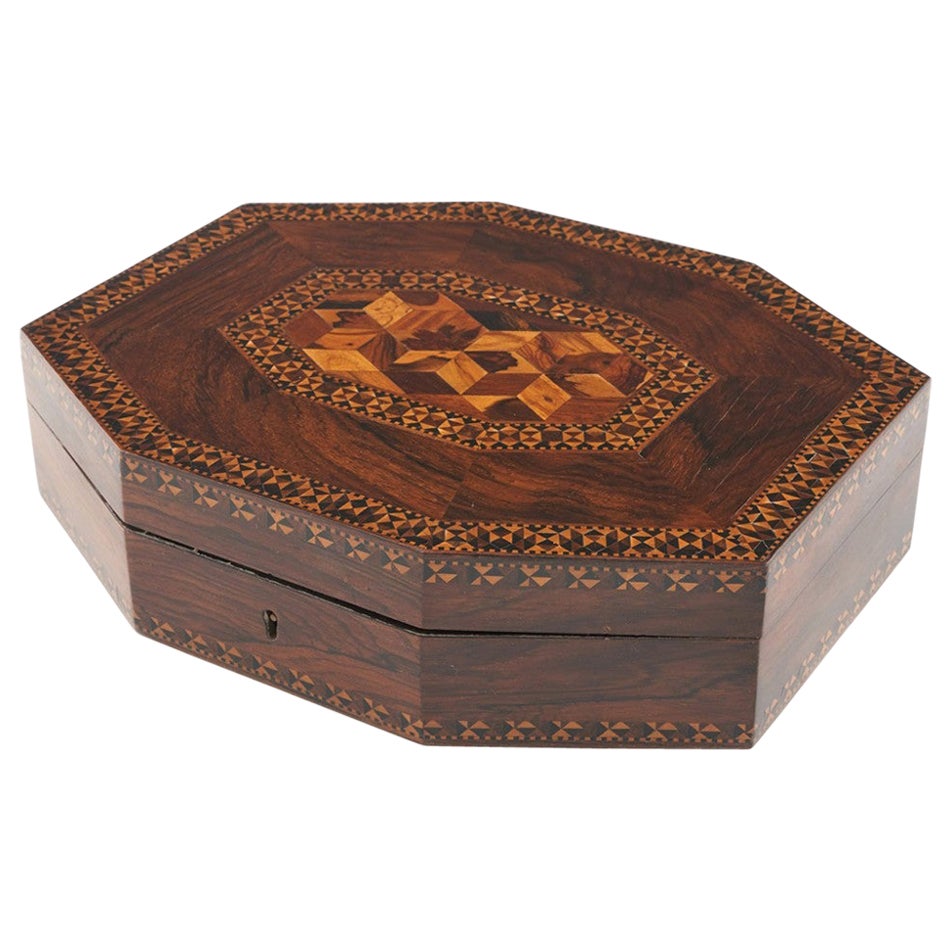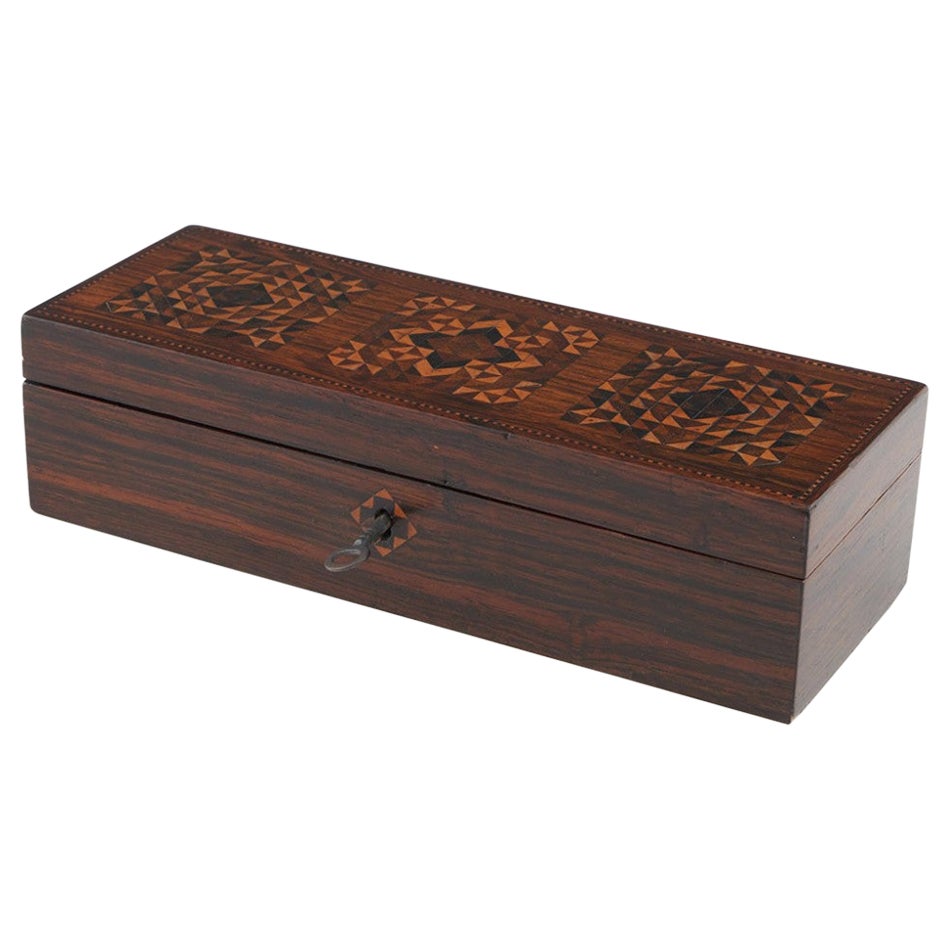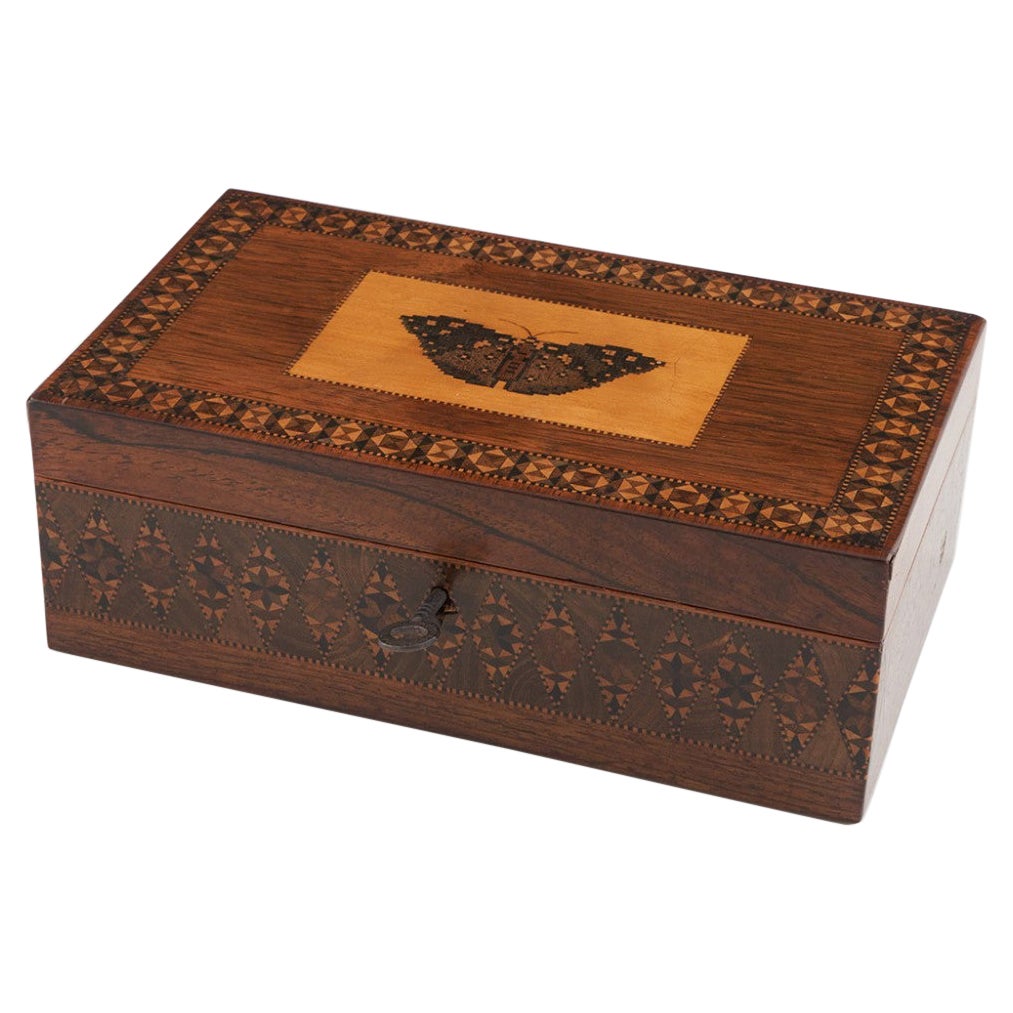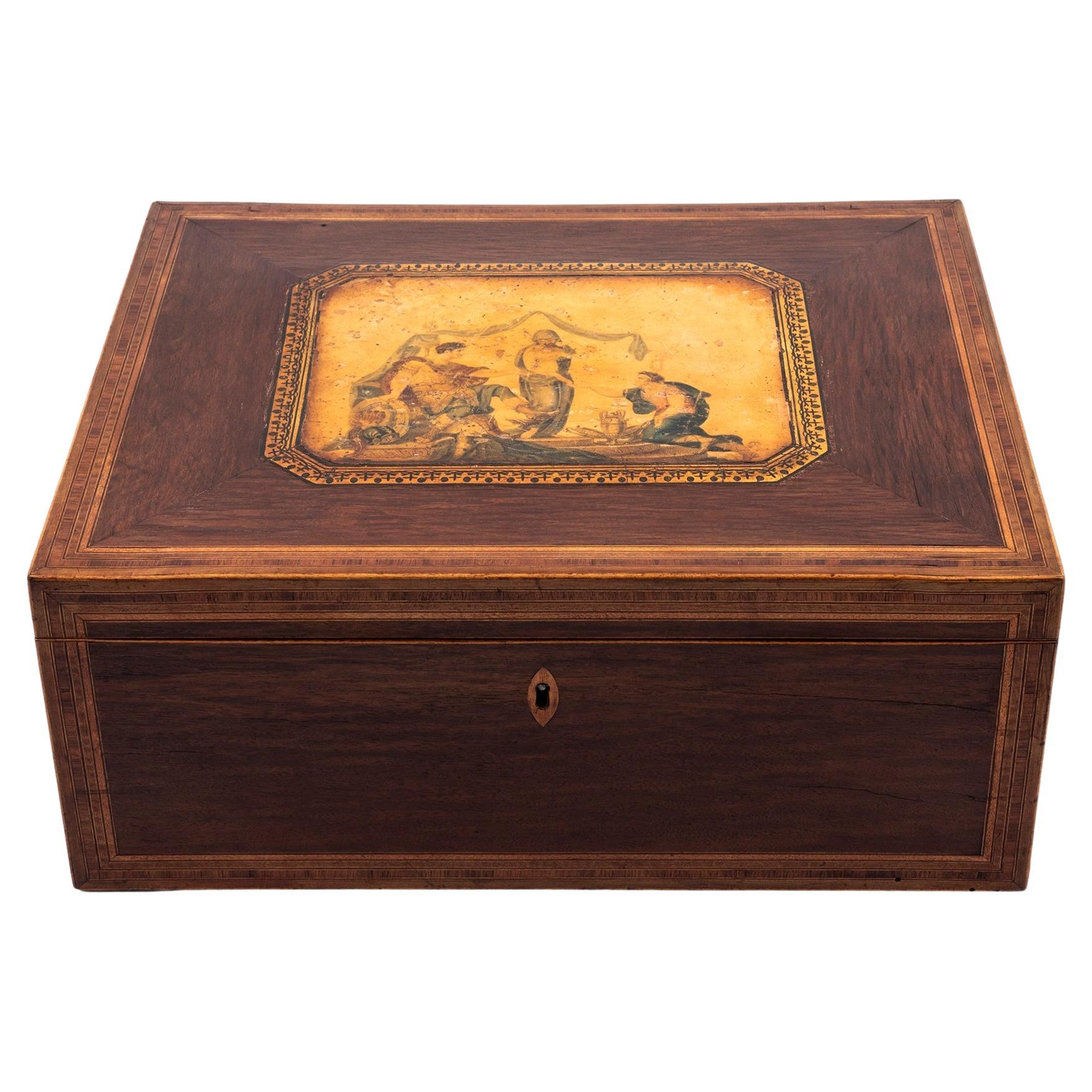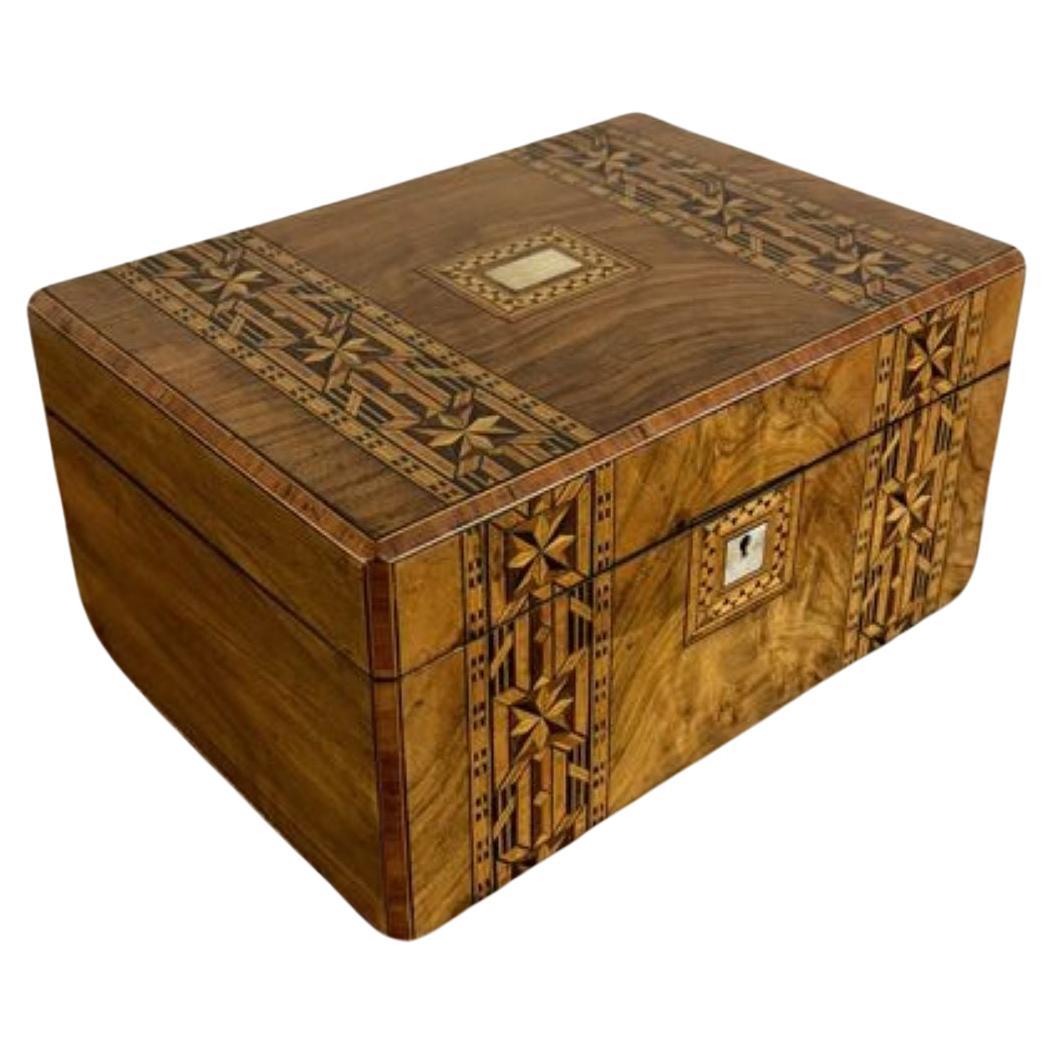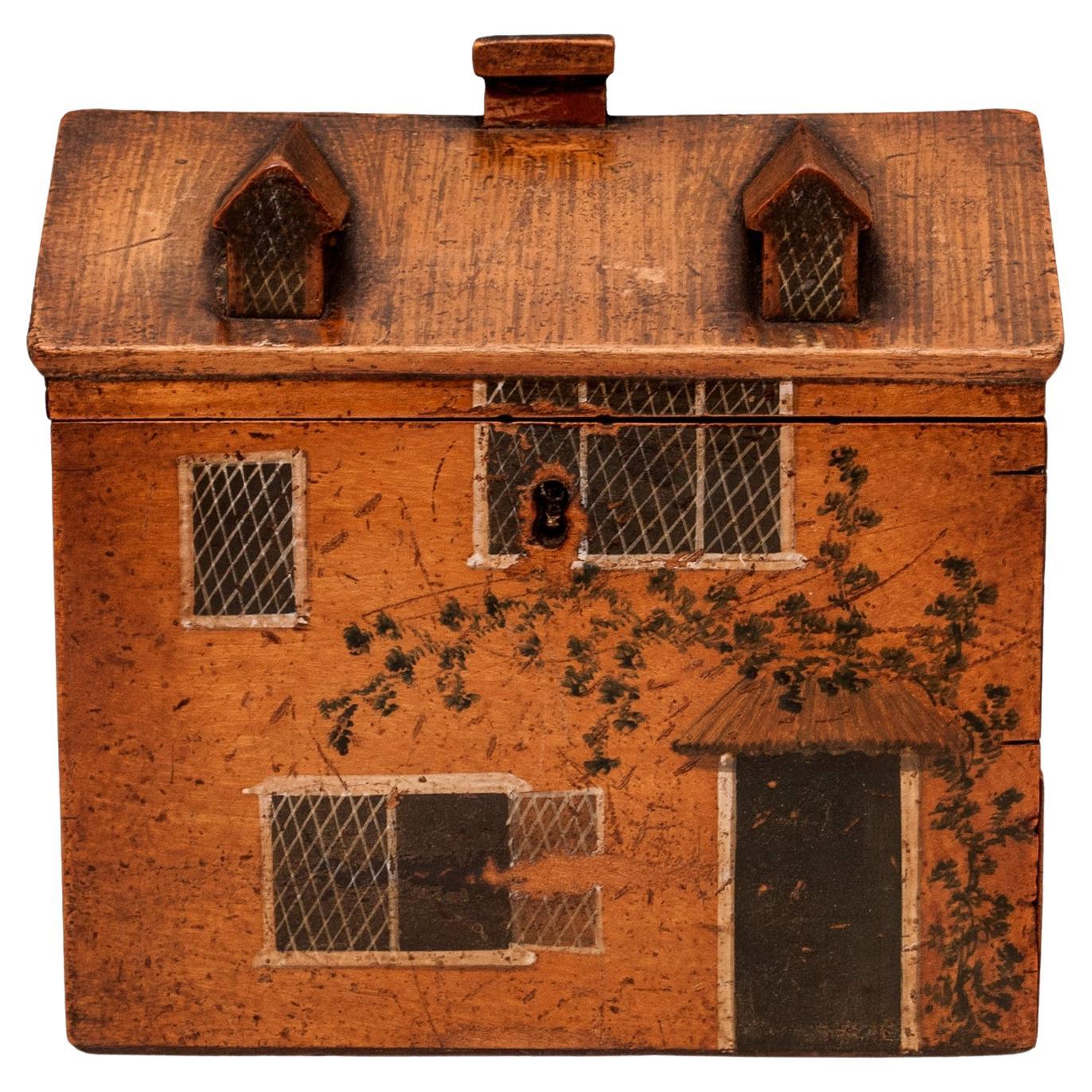Items Similar to Tunbridge Ware - A Very Finely Decorated Sewing Box, c1840
Want more images or videos?
Request additional images or videos from the seller
1 of 13
Tunbridge Ware - A Very Finely Decorated Sewing Box, c1840
About the Item
Tunbridge Ware - A Very Finely Decorated Sewing Box with 'Hurst Wood Cottage' Mosaic, c1840
Additional Information:
Heading: Tunbridge Ware - A Very Finely Decorated Sewing Box with 'Hurst Wood Cottage' Mosaic
Date : c1840
Period : Victorian
Origin : Tunbridge Wells; England
Decoration : To the lid: very fine geometric mosaic band within banded keyline stringing; this surrounds an intricate gauge-work mosaic image, made from some exceptionally finely-grained tesserae, picking out individual tiles, stones or shingles on the cottage itself, and separate pales to the surrounding fence; a broader frieze of geometric mosaic to the four sides of the body; the hinged lid lined with original embroidered silk; the remainder of the inside has be re-lined with marbled paper, but retains a very unusual metal finishing strip around the border of the lift-out tray; this features eight compartments including a fixed pin-cushion and a thimble-holder; the tray sits on two ledges fitted to the inside of the lower well; plain key-hole (no key); base lined with probably original plain blue/green paper
Size : 21.6 W x 16.5 D x 9.0 H cm
Condition : excellent; just one or two missing tesserae, plus restoration as below
Restoration : there's a 28mm strip of tiles lost from the back corner of the base which has been rather crudely replaced; there's a larger single piece of veneer to the lid immediately above this area which looks as if it may well be a replacement piece too; internal relining as above
Notes : This is a very fine version of the 'Hurst Wood' image, which is in itself a bit of a conundrum; the name has no real provenance, other than simply having been in common usage with collectors for some time. It was, however, shown in one of the go-to Tunbridge Ware source books - Colbran's New Guide For Tunbridge Wells, which was compiled and illustrated in the late 1830's. Here it is simply described as 'a newly-erected farm-house', without a name. It's position relative to the Toad Rock and the original turnpike (now the A264, Langton Road), in conjunction with a contemporary map of the area, do however place it very firmly at the end of Nevill Park and - contrary to popular belief - to the location of a dwelling which is still standing, retaining its distinctive layout, jettied first floor overhang, chimney configuration and finials.
The nature of the piece, it's general appearance and the occurrence of the Hurst Wood mosaic on other items which have more easily-identifiable features have lead us to attribute the sewing box to members of the Burrows clan, all Tunbridge Ware manufacturers who were working in the town during the appropriate period; the most notable piece which leads us to this conclusion is a two-compartment tea caddy featuring the same cottage mosaic along with the Burrows's very distinctive use of walnut root-wood veneer
- Dimensions:Height: 3.55 in (9 cm)Width: 8.51 in (21.6 cm)Depth: 6.5 in (16.5 cm)
- Style:Victorian (Of the Period)
- Materials and Techniques:
- Place of Origin:
- Period:
- Date of Manufacture:circa 1840
- Condition:Just one or two missing tesserae, plus restoration. There's a 28mm strip of tiles lost from the back corner of the base which has been rather crudely replaced; there's a larger single piece of veneer to the lid immediately above this area which looks.
- Seller Location:Tunbridge Wells, GB
- Reference Number:
About the Seller
5.0
Gold Seller
These expertly vetted sellers are highly rated and consistently exceed customer expectations.
Established in 2014
1stDibs seller since 2023
35 sales on 1stDibs
Typical response time: 3 hours
- ShippingRetrieving quote...Ships From: Tunbridge Wells, United Kingdom
- Return PolicyA return for this item may be initiated within 30 days of delivery.
More From This SellerView All
- Tunbridge Ware Sewing Box c1840By Tunbridge WareLocated in Tunbridge Wells, GBHeading : Tunbridge ware sewing box Date : c1840 Period : Victoria Origin : Tunbridge Wells, Kent Decoration : Central perspective cube patte...Category
Antique 1840s British Victorian Decorative Boxes
MaterialsWood
- Tunbridge Ware Glove Box c1840By Tunbridge WareLocated in Tunbridge Wells, GBHeading : Tunbridge ware glove box Date : c1840 Period : Victoria Origin : Tunbridge Wells, Kent Decoration : Three geometric stickware designs to cover with keyline border. Internal...Category
Antique 1840s British Early Victorian Decorative Boxes
MaterialsWood
- Tunbridge Ware Rosewood Workbox c1840Located in Tunbridge Wells, GBHeading : Tunbridge ware rosewood box Date : c1840 Period : Victoria Origin : Tunbridge Wells, Kent Decoration : Mosaic image of a butterfly within keylines. Geometric marquetry bord...Category
Antique 1840s British Victorian Decorative Boxes
MaterialsWood
- Tunbridge Ware - A Fine Sewing Box with Isometric Cubes, c1850By Edmund Nye Tunbridge WellsLocated in Tunbridge Wells, GBTunbridge Ware - A Fine Sewing Box with Isometric Cubes and Geometric Mosaics, c1850 Additional Information: Heading: Tunbridge Ware - A Fine Sewing Box with Isometric Cubes and Geo...Category
Antique 19th Century English Victorian Decorative Boxes
MaterialsOak
- A Very Fine Tunbridge Ware Writing Slope Box, c1850By Edmund Nye Tunbridge WellsLocated in Tunbridge Wells, GBA Very Fine Tunbridge Ware Writing Slope Box, c1850 Additional Information: Heading: A Very Fine Tunbridge Ware Writing Slope Date : c1850 and possibly a li...Category
Antique 19th Century English Victorian Decorative Boxes
MaterialsLeather, Wood
- Tunbridge Ware Sewing Box with Eridge Castle Topographic Mosaic, c1860Located in Tunbridge Wells, GBTunbridge Ware Sewing Box with Eridge Castle Topographic Mosaic, c1860 Additional Information: Heading: Tunbridge Ware - A Sewing Box with E...Category
Antique 19th Century English Victorian Decorative Boxes
MaterialsSatinwood
You May Also Like
- Regency Tunbridge Ware Sewing BoxBy Tunbridge WareLocated in Northampton, GBFitted Interior & Silver Handles From our Tunbridge Ware collection, we are delighted to offer this Tunbridge Ware Sewing Box. The Sewing Bo...Category
Antique Early 19th Century British Regency Decorative Boxes
MaterialsSatinwood
- Quality antique Victorian walnut tunbridge ware inlaid sewing boxLocated in Ipswich, GBQuality antique Victorian walnut tunbridge ware inlaid sewing box, having beautiful inlaid detail to the box with a lift up lid opening to reveal an interior tray above a storage com...Category
Antique 19th Century Early Victorian Decorative Boxes
MaterialsWalnut
- Georgian Tunbridge Ware Folk Art Cottage Sewing BoxBy Tunbridge WareLocated in Northampton, GBTunbridge Ware Folk House Sewing Box From our Sewing Box collection, we are thrilled to offer this Novelty Folk Art Cottage Sewing Box. The box of rectangular form made from Sycamor...Category
Antique Early 1800s British Georgian Decorative Boxes
MaterialsWood, Sycamore
- Tunbridge Ware BoxLocated in Dallas, TXLarge Tunbridge ware box with herringbone pattern inlaid parquetry. Circa 1840, England.Category
Antique 1840s English Decorative Boxes
MaterialsWood
- Brighton Pavilion Tunbridge Ware Sewing CompendiumBy Tunbridge WareLocated in Northampton, GBRare Tunbridge Ware Form Sewing Compendium From our Tunbridge Ware collection, we are delighted to offer this very rare Tunbridge Wear Sewing Compendium. The Sewing Compendium modelled as a tower from the Brighton Pavilion features the iconic minaret turned in Sycamore (aka white wood) and a large globular body with hand-painted details leading to further turned faces and the hand-painted windows upon a stepped base. The Sewing Compendium opens in two locations one just below the first dome revealing a pin cushion and the second just above the windows revealing the Sewing tools including a Tunbridge Ware thimble and bobbin. The Tunbridge Ware Sewing Compendium dates to the Georgian era during the reign of George IV circa 1825. Brighton Pavilion, The Royal Pavilion and surrounding gardens are a Grade I listed property and were the former Royal residence located in Brighton, England. It was built in 1787 in three stages as a seaside retreat for George, Prince of Wales who became the Prince Regent in 1811 and then King George IV in 1820. It is built in the Indo-Saracenic style prevalent in India for most of the 19th century. The current appearance of the Pavilion which has various domes and minarets, is the work of architect John Nash, who extended the building starting in 1815. George IV's successors William IV and Victoria also used the Pavilion but Queen Victoria decided that Osborne House should replace the Pavilion as the royal seaside retreat and therefore the Pavilion was sold to the city of Brighton in 1850. Indo-Sarascenic refers to a cross between Indian architecture and Muslim architecture. Minarets means beacon in Arabic. In Islamic religious architecture, the tower from which the faithful are called to prayer five times each day by a muezzin, or crier. Such a tower is connected to a mosque and has one or more balconies or open galleries. The inspiration for the minarets features on the Brighton Pavilion are in homage to these types of finials. John Nash (1752-1835) was one of the most prevalent British architects from the Georgian and Regency periods. He was responsible for the design, in the neoclassical and picturesque styles of many important areas of London. He was financed by the Prince Regent and by the era's most successful property developer, James Burton. Nash's most famous designs were the Brighton Pavilion, Marble Arch and Buckingham Palace. Sycamore is a member of the Maple family, found in Europe. It is light yellow in colour and is often a very clean wood, with a straight, fine grain. The wood is often pippy. However, these pips are usually a very similar colour to the rest of the wood making them hardly visible. Georgian, a period in British history dating from 1714-1837, the Georgian era after the Hanoverian kings George I, George II, George III and George IV. Tunbridge Ware Tunbridge Wells and Tunbridge in Kent, England became popular in the 17th Century for their therapeutic waters. By the 18th century, Tunbridge Wells was a hugely popular Spa resort. Shops and stalls were set up to sell local work of distinction to visitors as souvenirs. Many of the original boxes were decorated with all sorts of different kinds of designs. Many of the Tunbridge boxes...Category
Antique Early 19th Century British George IV Decorative Boxes
MaterialsWood, Sycamore
- Lovely antique Victorian tunbridge ware inlaid writing boxLocated in Ipswich, GBLovely antique Victorian tunbridge ware inlaid writing box having a lovely antique Victorian tunbridge ware inlaid wring box with beautiful detail to the box opening to reveal a pull...Category
Antique Early 19th Century Victorian Decorative Boxes
MaterialsWood
Recently Viewed
View AllMore Ways To Browse
Bohemian Glass Casket
Armor Plates Portugal
Silverware Box Gorham
Chase Reimann
Harden Bedroom Furniture Brass Handles
Lonka Lonka
Gold And Wood Box
Vizagapatam Ivory
Lucite And Chrome Box
English Chinoiserie Box
Bronze Box
Alessandro Mandruzzato Murano Glass Box
Russian Paper Mache Box
18th Century Bible Box
18th Century Family Bible
Vintage Water Sprinkler
Hotel Letter Box
Moroccan Perfume Bottle
